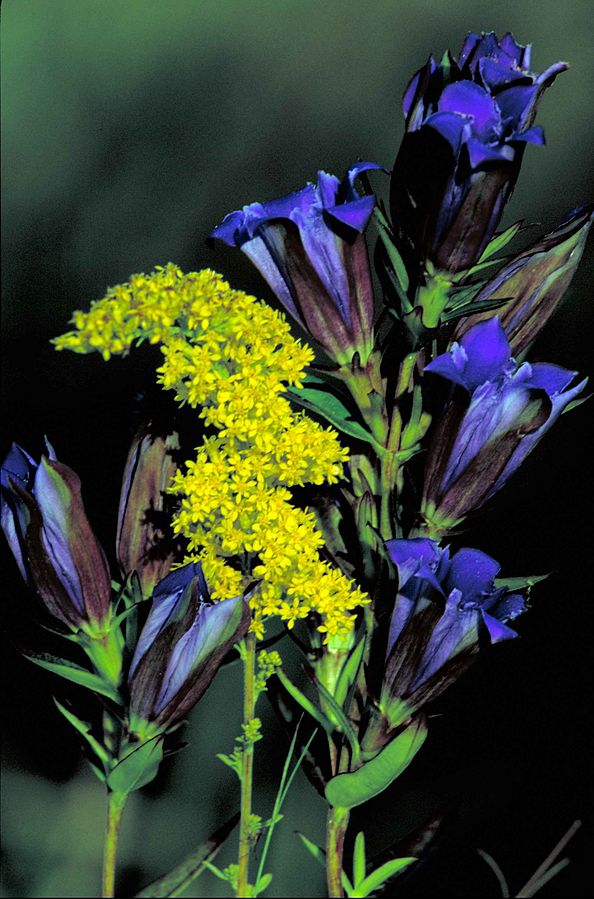Harvest Home
By Doris Webb [age 16]
Annotations by Mary Miller

The careful store of summer days
The earth with bounty yields,
And goldenrod [1], the fairies’ torch,
Is glowing in the fields.
When early gentians [2] peeping out
Reflect the heaven’s dome,
Across the golden fields we hear
The cry of, “Harvest home!”
And now the farmer toiling on
His distant homestead sees,
And once again we hear them shout
Beneath the shading trees.
And now they turn along the road
And gaily onward come
To gather for the yearly feast
The joyous harvest home.
Webb, Doris. “Harvest Home.” St. Nicholas Magazine
Vol. 28, no. 11 (september 1901): 1051.
[1] Goldenrod is a native flower that grows throughout the United States. It blooms in the late fall and has very bright yellow flowers that truly glow like a torch.
[2] Gentian is a fall-flowering herb with trumpet-shaped flowers, usually of an intense blue, which are reminiscent of a deep blue sky.
Gentian is native in alpine habitats in temperate regions of Asia, Europe and the Americas. Some species also occur in northwestern Africa, eastern Australia, and New Zealand.
Contexts
Doris Webb was sixteen when this poem was published in the September 1901 issue of St. Nicholas in the St. Nicholas League section.
The St. Nicholas League, with the motto “Live to learn and learn to live,” was a monthly feature in the magazine. The editors encouraged children to join the League and participate in competitions in prose, verse, drawing, photography, and both puzzle-making and puzzle-solving. The League’s founder and editor from 1899-1908, Albert Bigelow Paine, served as a mentor and tutor to the League’s members. He and the magazine’s longtime editor, Mary Mapes Dodge, judged the submissions and awarded prizes in the form of gold and silver badges. In the early twentieth century many Americans farmed for a living. St. Nicholas published “Harvest Home” in September 1901 among other autumnal-themed work.
Resources for Further Study
- Anna M. Recay’s essay “‘Live to learn and learn to live’: The St. Nicholas League and the Vocation of Childhood” is an in-depth analysis of the St. Nicholas League and its founding editor Albert Bigelow Paine. In the essay Recay explores the paradox inherent in Paine’s approach to training children in the arts: celebration of a child’s freedom and relationship with nature paired with an insistence in learning adult forms of literary expression.
- E. B. White, the author of Charlotte’s Web and Stuart Little, was active in the St. Nicholas League as a young writer, and later wrote “The St. Nicholas League” [password protected], an essay reflecting on its role in nurturing many young writers, among them Edna St. Vincent Millay, who had seven poems published.
- “St. Nicholas and Mary Mapes Dodge: The Legacy of a Children’s Magazine Editor, 1873-1905” is an anthology of critical essays about the magazine and Mary Mapes Dodge. The book is a treasure trove of information about the editors and contributors to St. Nicholas, regarded by many as one of the best children’s magazine ever published.
Contemporary Connections
An example of a contemporary version of St. Nicholas is Cricket Magazine, which began publishing in 1973. Founded by Marianne Carus, Cricket has a target audience of children from six to fourteen. It includes works from notable artists, including original stories, poems, folk tales, non-fiction articles, and illustrations. As did St. Nicholas, Cricket also runs contests and publishes work by its readers.
In 2011 a Canadian digital education platform, ePals Corporation, purchased Cricket and brought it into the digital age. The target audience has expanded to include children from birth to the age of fourteen. It is still alive and well and is now part of the Cricket Media enterprise.